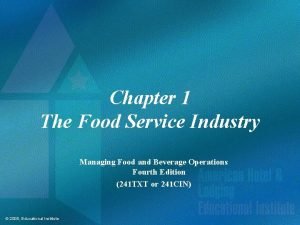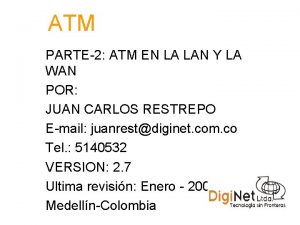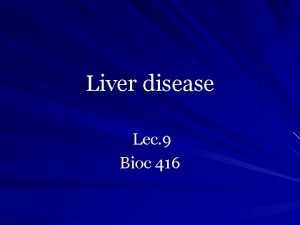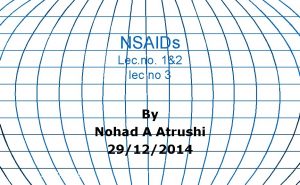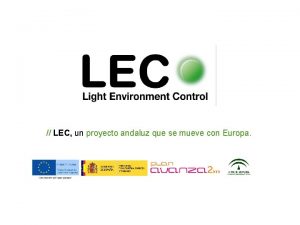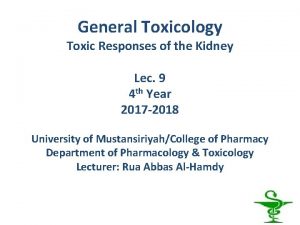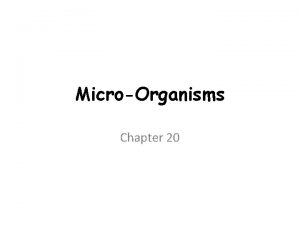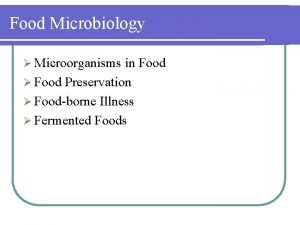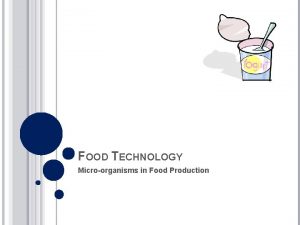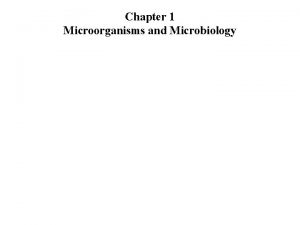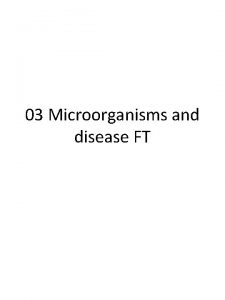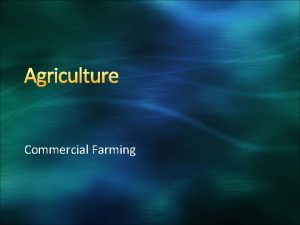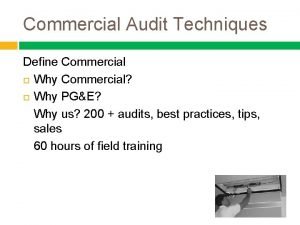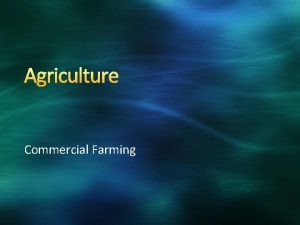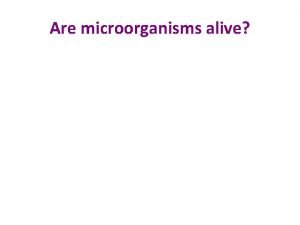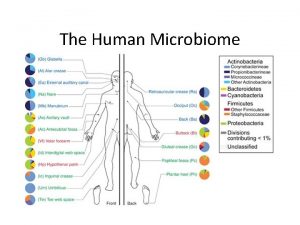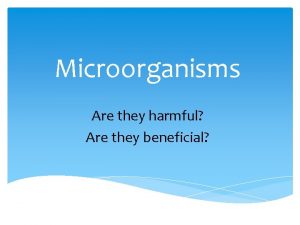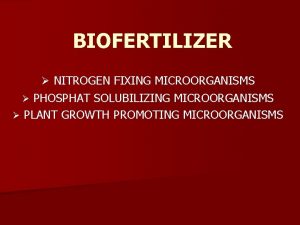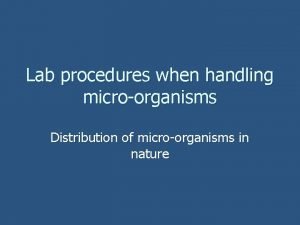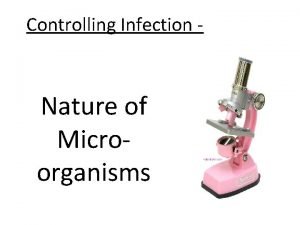Lec 9 Commercial products from microorganisms and food































- Slides: 31

Lec # 9 Commercial products from microorganisms and food biotechnology Dr. Shah Rukh Abbas 4 -2 -2015

Fermentation • Products from microorganism – metabolites – Enzymes – Antibiotics – Bioconversion – Fuel – microbial plastics

1. By-products of Microorganism vs chemical synthesis antibiotics, organic compounds, and pharmaceuticals. 2. Advantages reduce risks and complexities reduce cost and pollution less toxic and hazardous 3. environmental cleanup

Products from microorganisms The production of antibiotics through fermentation was a biotechnological breakthrough after World War II Microbial cells can now produce interferons, interleukins, factor VIII, erythropoietin, human insulin, , nerve growth factor human growth hormone 1. Metabolites • Primary metabolites-produced during the organism’s growth phase, those compounds are essential to an organism’s metabolites or end products. • Secondary metabolites- are not essential to cell growth or function and are characteristically produced quite late in the growth cycle.

Examples of primary and secondary metabolites produced by microbes Primary metabolites Secondary metabolites Amino acids Antibiotics Vitamins Pigments Nucleotides Toxins Polysaccharides Alkaloids Ethanol Many active pharmacological compounds (e. g cyclosporin, dopastin) Acetone Butanol Lactic acid

2. Enzymes Examples of microbial enzymes and their uses Enzymes Uses Lipase Enhances flavour in cheese making Lactase Breaks down lactose to glucose and galactose: lactose free milk products Protenase Digests proteins α-amylase Production of high fructose corn syrup Tissue plasminogen activators (TPA) Dissolves blood clots

3. Antibiotics (i) Characteristics -small metabolites with antimicrobial activity -produced by Gram-positive, Gram-negative and fungi (ii) Action in different ways -disrupting the plasma membrane of microbial cells -inhibiting cell wall synthesis, -inhibiting synthesis of important metabolites such as proteins, nucleic acid, and folic acid. (iii) develop new antibiotics with recombinant DNA biotechnology - combining antibiotic biosynthetic pathways and the targeted genetic modification of pathways. - feeding unusual substrates to microorganism that contains a pathway from another organisms


4. Bioconversions (i) Definition: - Microorganisms modify a given compound to a structurally related compound. - Bioconversion are useful when a multistep chemical synthesis is more expensive or inefficient or is impossible to achieve e. g recovering products from a large animal source. • Various steroid hormones such as Cortisone, used to treat pain and inflamation, and Progesterone, used to prevent miscariages, can be synthesised commercially by microorganisms. • The process involves providing an appropriate microorganism with a commonly available sterol compound that it can convert to medically valuable hormone.

INFORM. vol. 2. no. 3 (March 1991)

‘Biochemicals from bacterial factories’, Materials. www. research. bayer. com/renewables

(ii). The use of immobilized cells (immobilized enzymes) - technology has been developed for the immobilization of enzymes onto waterinsoluble supports - minimized the cost of production by permitting repeated use of the enzymes - substantially increased the stability of the enzymes The use of whole cell systems obviates enzyme isolation and immobilization

5. Fuels (i) Methane-a cleaner and renewable alternatives, a natural gas produced by anaerobic bacteria in swamps and landfills. (ii) Hydrogen-combustion produces only energy and water. Two hydrogen ion-----> hydrogen gas Hydrogenase in bacterial, such as Clostridium and eukaryotic algae Chlorella. Bacterial enzyme hydrogenase readily produce hydrogen gas from two hydrogen ions.

Advantages of H 2 • Much lighter than air • Rapid diffusivity (3. 8 times faster than natural gas) • Non-flammable concentration (quickly) • Non-toxic • There are H 2 fuel cell cars. Concerns: • Its extremely combustible; there are concern for its storage • High cost of its extraction Atmospheric pollution or water pollution Fuel CO 2 released per 1000 k. J energy H 2 0 CH 4 1. 2 Petroleum 1. 6 Coal 1. 9 Ethanol 1. 6 Biomass 2. 2

5. Plastics (i) a global industry providing more than 300 billion pounds per year of materials valued at over $150 billion. - extraction and processing of fossil carbon and increases of greenhouse gases accumulation (ii) Biodegradable microbial bioplastics- PHA (poly hydroxyalkanoate) - a group of microorganisms including Acinetobactor, Clostridium, Microcystis, Pseudomonas, Rhizobium, Spirulina, Streptomyces produces PHA for storage of energy. - the desired polymers are produced by supplying microbes defined nutrients in correct ratios.

- R can be hydrogen or hydrocarbon chains of up to around C 13 in length, and x can range from 1 to 3 or more. Varying x and R effect hydrophobicity, Tg, Tm, and level of crystallinity. When R is a methyl group and x=1, the polymer is poly-3 - hydroxybutyric acid (PHB), the base homopolymer in the PHA family. When R is a methyl group and x=0, the polymer is polylactic acid (PLA)

Food Biotechnology • Food biotechnology is the application of technology to modify genes of animals, plants, and microorganisms to create new species which have desired production, marketing, or nutrition related properties • Food biotechnology is and will continue to be an important area in science as the world’s human population continues to increase and the world’s agricultural lands continue to decrease.

Why genetically modify food?

1) Extended Shelf Life • The first steps in genetic modification were for food producers to ensure larger profits by keeping food fresher, longer. • This allowed for further travel to and longer availability at markets, etc… Extended Shelf Life Milk

Example: Long Shelf Tomatoes �These genetically modified tomatoes promise less waste and higher profits. �Typically, tomatoes produce a protein that softens them after they have been picked. �Scientists can now introduce a gene into a tomato plant that blocks synthesis of the softening protein. �Without this protein, the genetically altered tomato softens more slowly than a regular tomato, enabling farmers to harvest it at its most flavorful and nutritious vine-ripe stage.

2) Efficient Food Processing • By genetically modifying food producing organisms, the wait time and quantity of certain food processing necessities are optimized. • Again this is a money saver.

Example: Rennin Production �The protein rennin is used to coagulate milk in the production of cheese. �Rennin has traditionally been made in the stomachs of calves which is a costly process. �Now scientists can insert a copy of the rennin gene into bacteria and then use bacterial cultures to mass produce rennin. �This saves time, money, space and animals. Rennin in the top test tube… not there in the bottom one.

3) Better Nutrient Composition �Some plants, during processing, lose some of the vital nutrients they once possessed. �Others are grown in nutrient poor areas. �Both these problems can be solved by introducing genes into plants to increase the amount or potency of nutrients. �“Biofortification”

Example: Golden Rice � Scientists have engineered "golden rice", which has received genes from a daffodil and a bacterium that enable it to make beta-carotene. � This offers some promise in helping to correct a worldwide Vitamin A deficiency.

4) Efficient Drug Delivery • Inserting genes into plants/animals to produce essential medicine or vaccines. • “Biopharming”

Many Unpatented Examples • A cow with the genetic equipment to make a vaccine in its milk could provide both nourishment and immunization to a whole village of people now left unprotected because they lack food and medical help (in progress). • Bananas and potatoes make hepatitis vaccines (done). • Making AIDS drugs from tobacco leaves (done). • Harvest vaccines by genetically altering hydroponically grown tomato plants to secrete protein through their root systems into the water (done).

Potential Problems? ? ? • With every technology there is an associated risk involved. • The following are some examples of potential problems associated with food biotechnology.

1) Creating “Superbugs” �Since many of the “vectors” used to introduce genes to plants and animals are bacteria and viruses, it is realistic to think there is a chance they could undergo a mutation and prove harmful or become recombinant like the H 1 N 1 virus and thus more virulent. �However, the bacteria and viruses used in these procedures are usually nonpathogenic. Viruses Bacteria

2) Negative Affects on Human Health • Most of these food products undergo testing to see if any adverse health effects occur. • However, allergies were not thought of in one case where a gene from a brazil nut was transferred to soy bean plants! • Thankfully a food product was not pursued as someone came to their senses! • Important to note that not all genes from a potential allergenic food will cause an allergy.

3) Ethics �How many human genes would an organism have to have before you consider it human? ? ? �The following food types have a variety with human genes added: rice (immune system genes that prevent diarrhea), baby food (lactoferrin and lysozyme) and any farm animal (Human growth hormone).

Assignment 3 1) What is the best reason for genetically modifying food? 2) What is a potential problem that you feel should be studied further before advancing farther into food biotechnology?
 Noncommercial food service
Noncommercial food service Raroc in banking
Raroc in banking Functional product
Functional product Flora fauna and microorganisms
Flora fauna and microorganisms Marketing mix of pepsi and coca cola
Marketing mix of pepsi and coca cola Lec scoreboard
Lec scoreboard 11th chemistry thermodynamics lec 13
11th chemistry thermodynamics lec 13 Lec ditto
Lec ditto Lec scoreboard
Lec scoreboard Componentes del lec
Componentes del lec 11th chemistry thermodynamics lec 10
11th chemistry thermodynamics lec 10 Lec elements
Lec elements August lec 250
August lec 250 Underground pipeline irrigation system
Underground pipeline irrigation system Lec material
Lec material Apelacin
Apelacin Lec
Lec 132000 lec
132000 lec Lec@b@ret
Lec@b@ret Tipos de lec
Tipos de lec Sekisui slec
Sekisui slec 416 lec
416 lec Lec
Lec Back work ratio formula
Back work ratio formula Lec promotion
Lec promotion Lec anatomia
Lec anatomia Lec hardver
Lec hardver Fenemates
Fenemates Lecsl
Lecsl Lec hardver
Lec hardver Lec renal
Lec renal 252 lec
252 lec
